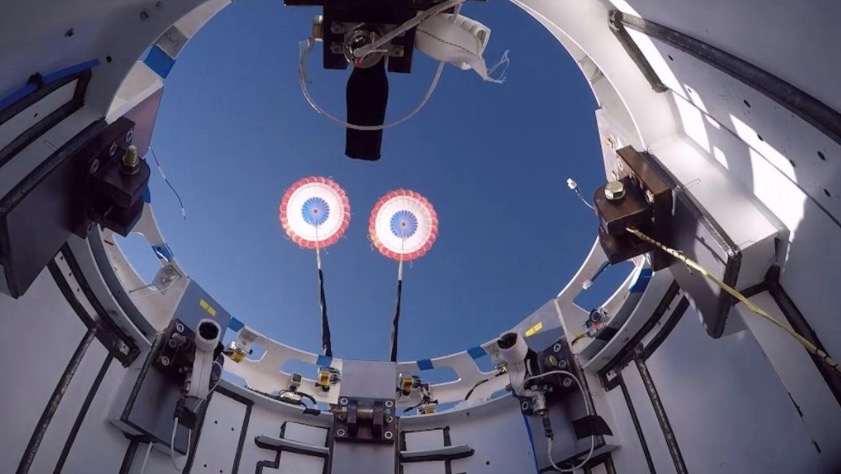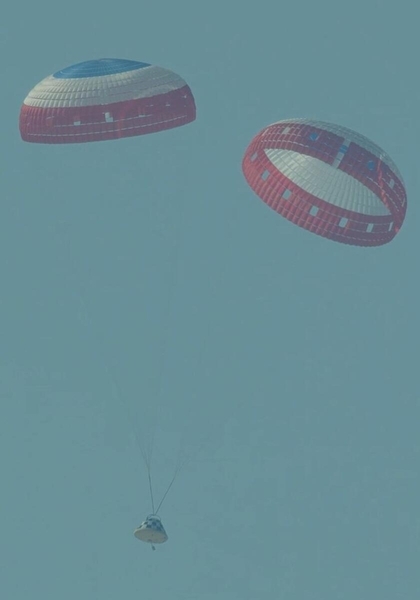
The parachute system that helps bring Boeing's Starliner crew capsule safely back to Earth just passed another test.
Starliner's chutes performed well during a drop test over New Mexico's White Sands Space Harbor last week that was designed to simulate an abort shortly after launch, Boeing representatives said Monday (June 29).
"Parachutes like clean air flow," Boeing flight conductor Jim Harder said in a statement.
"They inflate predictably under a wide range of conditions, but in certain ascent aborts, you are deploying these parachutes into more unsteady air where proper inflation becomes less predictable," Harder said. "We wanted to test the inflation characteristics at low dynamic pressure so we can be completely confident in the system we developed."
Related: Boeing's 1st Starliner flight test in photos
A Starliner test article was dropped from a balloon high in the New Mexico sky on Sunday, June 21. Six seconds after the drop, small chutes deployed as planned, lifting away the capsule's forward heat shield. Shortly thereafter, the vehicle's two drogue parachutes kicked in, deploying successfully despite the low pressure, Boeing representatives said.
Then, 98 seconds post-drop, two pilot chutes fired, pulling out two of Starliner's three main parachutes. The test team kept the third main chute stowed by design, introducing a "fault scenario" for the system to overcome.
Get the Space.com Newsletter
Breaking space news, the latest updates on rocket launches, skywatching events and more!
The two deployed main chutes did their job, helping the test article land softly in the New Mexico desert about 4 minutes after the drop, Boeing representatives said. (This scenario mirrored what happened during Starliner's November 2019 "pad abort" test, but on that earlier occasion the plan had been for all three of the main parachutes to deploy.)
"Our parachutes have passed every test," Starliner test manager Dan Niedermaier said in the same statement. "We continue to push our system because we know what's at stake. This demanding test program ensures Starliner can bring our astronauts home safe."
Boeing has been developing Starliner with funding help from NASA's Commercial Crew Program and will use the capsule to fly agency astronauts to and from the International Space Station (ISS).
Starliner is in the late stages of its test program. The capsule has already made one trip to space, an uncrewed December 2019 mission called Orbital Flight Test (OFT). OFT didn't go as planned; Starliner suffered a glitch with its onboard timing system and got stranded in the wrong orbit, preventing a meetup with the ISS. The capsule did ace its landing, however, touching down softly in New Mexico under parachute.
Starliner will fly another version of OFT, likely sometime late this year, before taking astronauts aboard on a test flight to the space station.

SpaceX holds a NASA commercial crew deal of its own, which it will fulfill using its Crew Dragon capsule and Falcon 9 rocket. Crew Dragon has already flown successfully to the ISS twice, first on an uncrewed test flight in March 2019 and again on the Demo-2 demonstration mission, which launched on May 30 of this year.
Demo-2 took NASA astronauts Bob Behnken and Doug Hurley to the orbiting lab, where they remain today. It's unclear how much longer the duo will stay in orbit; NASA officials said shortly before launch that Demo-2 will last one to four months end to end, and they have yet to get more specific than that.
If all continues to go well with Demo-2, SpaceX's first contracted commercial crew mission for NASA could launch as early as Aug. 30.
Boeing will continue to test Starliner's parachutes throughout this summer, putting the system through its paces in a variety of conditions, NASA officials said.
Mike Wall is the author of "Out There" (Grand Central Publishing, 2018; illustrated by Karl Tate), a book about the search for alien life. Follow him on Twitter @michaeldwall. Follow us on Twitter @Spacedotcom or Facebook.
Join our Space Forums to keep talking space on the latest missions, night sky and more! And if you have a news tip, correction or comment, let us know at: community@space.com.

Michael Wall is a Senior Space Writer with Space.com and joined the team in 2010. He primarily covers exoplanets, spaceflight and military space, but has been known to dabble in the space art beat. His book about the search for alien life, "Out There," was published on Nov. 13, 2018. Before becoming a science writer, Michael worked as a herpetologist and wildlife biologist. He has a Ph.D. in evolutionary biology from the University of Sydney, Australia, a bachelor's degree from the University of Arizona, and a graduate certificate in science writing from the University of California, Santa Cruz. To find out what his latest project is, you can follow Michael on Twitter.









